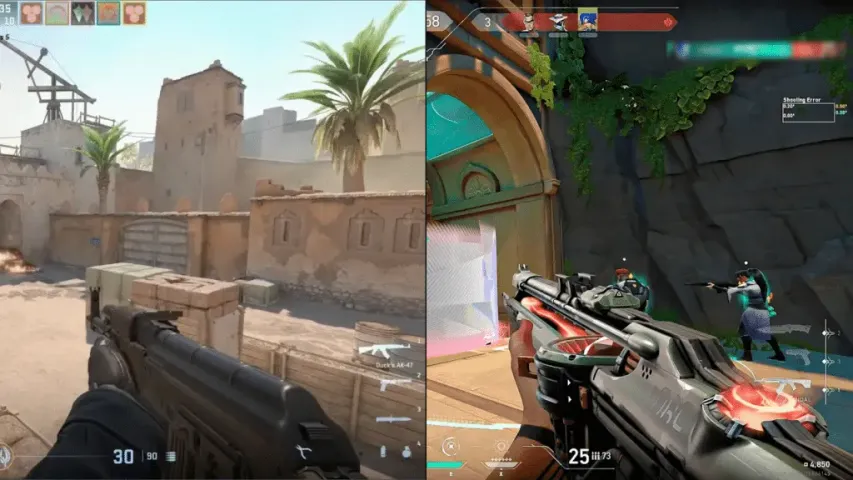
VALORANT and Counter-Strike 2 are two of the most prominent first-person shooters in the esports arena, each boasting a massive following and a robust competitive scene. VALORANT, developed by Riot Games, combines tactical shooter mechanics with unique agent abilities, creating a dynamic and strategic gameplay experience. CS2, the latest iteration of the legendary Counter-Strike series by Valve, focuses on realistic shooting mechanics and deep tactical gameplay. Both games have established themselves as pillars of the esports world, but they offer different experiences for players and fans alike. This comparison aims to explore the key differences between VALORANT and CS2 in terms of match frequency, season structure, prize pools, income sources, and more.
Match Frequency and Season Structure
VALORANT
In 2023, VALORANT's competitive scene was centred around the VALORANT Champions Tour (VCT), which includes multiple stages: Challengers, Masters, and Champions. Each stage consists of several events where teams compete to qualify for the next level.
- Evil Geniuses: Played 4 events, totaling 78 maps.
- Fnatic: Played 5 events, totaling 75 maps.
- Paper Rex: Played 5 events, totaling 75 maps.
The structure of VALORANT's competitive season emphasizes major events where the best teams from different regions face off. The relatively fewer events and maps played by top teams indicate a focus on quality over quantity, with high-stakes matches that attract significant viewership and attention.


CS2
The competitive landscape of CS2 (since October 2023, formerly CS:GO) is characterized by a larger number of events and a higher frequency of matches. The CS2 scene includes major leagues such as the ESL Pro League, BLAST Premier, and Valve-sponsored Majors, along with numerous other tournaments throughout the year.
CS2's season structure is more extensive, with top teams participating in many events across different tiers. This results in a higher number of matches, providing teams with more opportunities to compete, earn prize money, and improve their rankings. The frequent competitions keep the community engaged year-round and ensure continuous action for fans.
Income Sources for Players
Both VALORANT and CS2 offer multiple avenues for professional players to earn income. These sources include salaries from esports organizations, prize winnings from tournaments, sponsorship deals, streaming and content creation, skin sales, and individual brand partnerships. The specifics of these income sources can vary significantly between the two games.
Salaries
VALORANT:
- Many top VALORANT players, especially those not playing for VCT-partnered teams, earn between $20,000-$40,000 per month.
- Salaries can vary based on the player's skill level, team performance, and individual popularity.
- Some elite players may earn even higher salaries, depending on their marketability and competitive success.
CS2:
- In Counter-Strike, salaries are a significant component of player income. For instance, top players like FaZe’s Robin “ropz” Kool earned around €800,000 annually, which includes prize money and revenue from skin sales, but the majority comes from their salaries.
- Salaries for top-tier players in CS2 can reach similar figures as in VALORANT, with annual earnings often exceeding several hundred thousand dollars.


Prize Winnings
VALORANT:
- Top teams earn significant prize money from major events. For example, Evil Geniuses earned $1,250,000 in 2023, while Fnatic and Paper Rex each earned $645,000.
- The overall prize pool for VALORANT in 2023 was $10,410,989.
CS2:
- Prize winnings are a substantial part of player income, with FaZe earning $2,370,000, Vitality $2,024,000, and G2 $1,103,500 in 2023.
- The total prize money for CS2 in 2023 was $22,862,158, reflecting a larger competitive ecosystem with more tournaments and prize opportunities.
Sponsorships and Brand Deals
VALORANT:
- Players secure sponsorship deals with brands, enhancing their earnings beyond salaries and prize winnings.
- High-profile sponsorships, such as individual brand partnerships, can significantly boost a player's income.
CS2:
- Sponsorship deals are a crucial income source, with players and teams often partnering with gaming peripherals, apparel brands, and other esports-related companies.
- Players like Tyson ‘TenZ’ Ngo from VALORANT have struck lucrative individual deals, such as his collaboration with Finalmouse, which generated $7.6 million in revenue.

Streaming and Content Creation
VALORANT:
- Many VALORANT players leverage platforms like Twitch and YouTube to generate additional income through streaming and content creation.
- Streaming allows players to monetize their audience through ads, subscriptions, and donations.
CS2:
- Streaming is a significant revenue source for CS2 players as well, with platforms like Twitch and YouTube providing substantial income through ads, subscriptions, and viewer donations.
- Many players balance competitive play with content creation, engaging with their fan base and building personal brands.

Skin Sales
VALORANT:
- Revenue from skin sales, such as the Champions skins, is shared with teams, providing an additional income stream.
- For example, the Champions skins generated $32 million in revenue, with $16 million distributed among participating teams.
CS2:
- CS2 features a robust skin economy where players and teams earn revenue from sales of esports-specific skins.
- Revenue from skin sales is often shared between teams and players, contributing to their overall earnings.
Prize Pools and Earnings
Understanding the prize pools and earnings is crucial to comparing the financial landscapes of VALORANT and CS2. Both games offer substantial prize money, but the structure and distribution of these earnings can differ significantly.
VALORANT
- Major Tournaments:
- VALORANT Champions Tour (VCT) 2023: VALORANT’s primary competitive circuit includes multiple stages: Challengers, Masters, and Champions.
- Evil Geniuses: $1,250,000 from 4 events.
- Fnatic: $645,000 from 5 events.
- Paper Rex: $645,000 from 5 events.
- Overall Prize Money in 2023: $10,410,989
VALORANT’s prize pool is distributed across fewer but larger events, which means that top teams earn significant sums from a smaller number of high-stakes tournaments. The VCT system emphasizes major international events, which contribute heavily to the overall prize pool.


CS2
- Major Tournaments:
- PGL Major Copenhagen 2024: One of the biggest events with a prize pool of $1,250,000.
- ESL Pro League and BLAST Premier: Regular high-stakes tournaments with significant prize money.
- FaZe: $2,370,000 from 18 events.
- Vitality: $2,024,000 from 14 events.
- G2: $1,103,500 from 16 events.
- Overall Prize Money in 2023: $22,862,158
CS2 offers a more extensive array of tournaments, including numerous tier-2 and tier-3 events, which contribute to a larger overall prize pool. The prize money in CS2 is spread across a wide range of events, providing more opportunities for various teams to earn.
Roster Changes and Player Transfers
VALORANT
- Roster Changes: VALORANT teams often undergo roster changes between VCT stages and during the off-season. Riot Games regulates player transfers, ensuring structured and fair processes.
- Player Transfers: Transfers are typically announced through official channels, with players moving between teams based on performance and strategic needs. The structured nature of Riot Games' regulations helps maintain stability and fairness in the transfer market.

CS2
- Roster Changes: Roster changes in CS2 are frequent, especially following major tournaments and during designated transfer windows. Teams often make changes to improve performance or adapt to strategic shifts within the competitive scene.
- Player Transfers: Valve and tournament organizers regulate player transfers, ensuring compliance with contractual obligations. The CS2 transfer market is dynamic, with players frequently moving between teams to find better opportunities and improve team synergy.
Player Breaks and Off-Season
VALORANT
- Off-Season: VALORANT's off-season starts on August 26th and continues until the next year. This extended break allows players to rest and recuperate, providing ample time for teams to plan and execute roster changes.

CS2
- Player Breaks: CS2 has two designated break periods:
- Summer Break: June 17th to July 16th.
- Winter Break: December 16th to January 12th.
- These breaks provide players with the necessary downtime to rest and prepare for upcoming competitions.

Conclusion
Both VALORANT and CS2 offer vibrant and competitive esports scenes with unique structures and financial opportunities for players. VALORANT emphasizes high stakes, fewer events with large prize pools, structured roster changes, and a longer off-season, reflecting its focus on quality over quantity. On the other hand, CS2 features a broader tournament circuit with higher overall prize money, frequent roster changes, and two regular player breaks, catering to continuous engagement and opportunities for teams and players.
Key Takeaways:
- Match Frequency and Season Structure: CS2 has a broader range of tournaments and more frequent matches, while VALORANT focuses on fewer, larger events.
- Prize Pools and Earnings: CS2 offers higher total prize money with extensive earning opportunities, whereas VALORANT provides substantial rewards in fewer, high-stakes events.
- Income Sources: Both games offer multiple income sources, including salaries, prize winnings, sponsorships, streaming, and skin sales.
- Roster Changes and Transfers: VALORANT has structured, regulated changes, while CS2’s dynamic market allows frequent player movements.
- Player Breaks and Off-Season: VALORANT’s extended off-season contrasts with CS2’s shorter, more frequent breaks.
Ultimately, the choice between VALORANT and CS2 depends on individual preferences, strategic goals, and desired experiences within the esports ecosystem. Both games continue to evolve, offering exciting opportunities and competitive challenges for players worldwide.







No comments yet! Be the first one to react